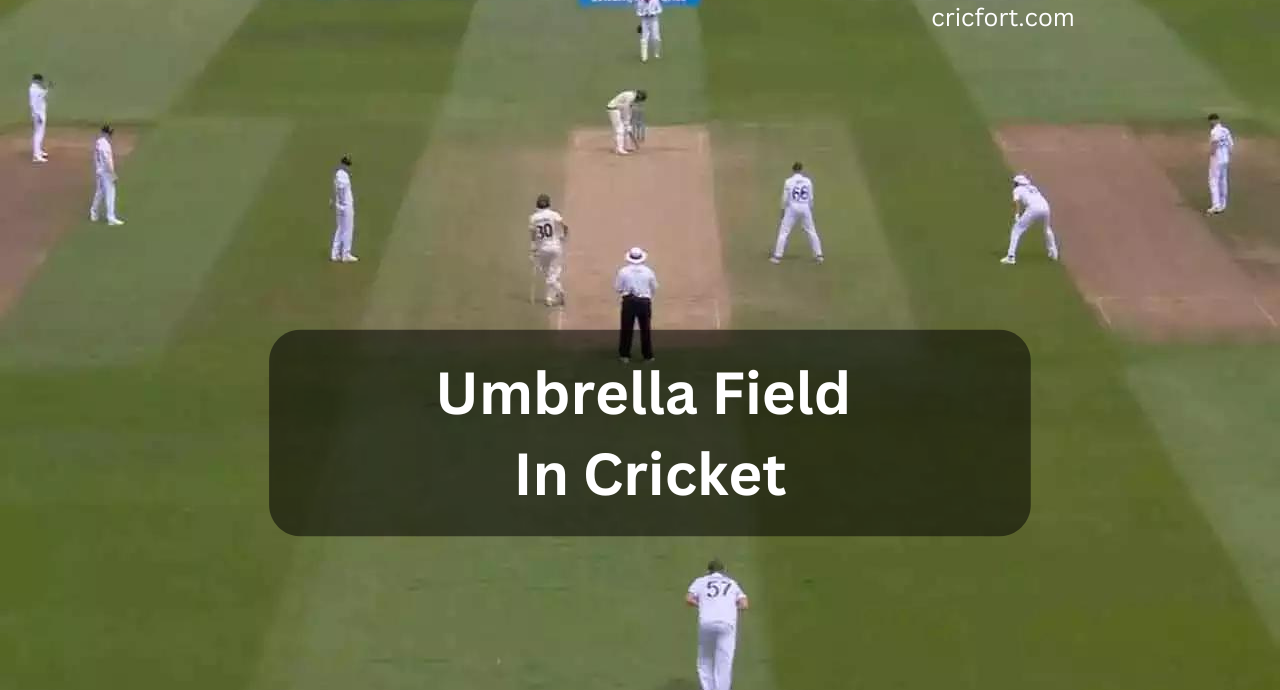Cricket, often known for its strategic depth, heavily relies on field placements as much as on bowling and batting. Among the various fielding setups, the “Umbrella Field” stands out for its strategic importance. This fielding arrangement is crucial for controlling the flow of runs and exerting pressure on the batsmen. In this comprehensive guide, we will explore the details of the Umbrella Field, including how to set it up, its strategic purpose, and when to use it.
Understanding the Umbrella Field
The Umbrella Field is a specific arrangement used mainly in One Day Internationals (ODIs) and Twenty20 (T20) cricket formats. The main goal is to protect the boundaries and limit the batsmen’s scoring opportunities, especially when they seek to accelerate the game. The name “Umbrella Field” reflects the shape of this fielding setup, which resembles an open umbrella.
Formation of the Umbrella Field
To set up the Umbrella Field, position the fielders in a semi-circle or arc around the batsman. The typical positions include:
- Fine Leg: Place this fielder behind the batsman on the leg side, close to the boundary. This fielder stops balls that deflect off the bat or are edged.
- Square Leg: Position this fielder on the leg side, closer to the batsman than the Fine Leg. This fielder intercepts balls pulled or flicked by the batsman.
- Midwicket: Set this fielder on the leg side, slightly in front of the Square Leg. This fielder covers the area where batsmen often play aggressive shots, like the pull or the sweep.
- Cover Point: Position this fielder on the off side, usually to the right of the batsman. This fielder is crucial for intercepting balls cut or driven through the off side.
- Extra Cover: Place this fielder on the off side, further forward than the Cover Point. This fielder helps stop well-timed drives and cuts aimed at the boundary.
- Long Off and Long On: Position these fielders at the boundary line on either side of the pitch. They are vital for catching or stopping powerful shots lofted towards the boundaries.
Typically, the Umbrella Field setup involves two or three fielders within the circle and additional fielders stationed on the boundary line. Adjustments can be made based on the bowler’s plan and the batsman’s tendencies.
Strategic Purpose of the Umbrella Field
The Umbrella Field serves several strategic purposes:
- Containment: This setup aims to restrict the batsman’s scoring opportunities. By placing fielders in key positions, the captain seeks to cut off easy singles and limit boundaries.
- Pressure: The strategic placement of fielders increases pressure on the batsman, potentially leading to mistakes and wickets.
- Boundary Control: Long Off and Long On ensure that aggressive shots aimed at the boundaries are well-covered. This setup proves useful in the final overs of a limited-overs game when the batting side aims to score quickly.
- Adaptability: Adjust the Umbrella Field based on the bowler’s strategy and the batsman’s strengths and weaknesses. For instance, if a batsman favors aggressive shots through the leg side, adjust the fielding positions to cover that area more effectively.
When to Use the Umbrella Field
You should consider using the Umbrella Field in the following scenarios:
- During the Death Overs: In limited-overs cricket, the final overs are known as the death overs, where batsmen play aggressively to maximize runs. The Umbrella Field helps control the scoring rate during these crucial overs.
- When a Batsman is in Form: If a particular batsman is playing aggressively and scoring freely, employ the Umbrella Field to curb their scoring rate and apply pressure.
- Against Hard-Hitting Batsmen: For batsmen known for powerful hitting, especially those targeting boundaries, the Umbrella Field can limit their opportunities to score freely.
- When Defending a Target: If defending a modest total, set up an Umbrella Field to maintain tight control over the scoring rate and prevent the batting side from easily chasing down the target.
Examples from International Cricket
Here are some real-world examples illustrating the effectiveness of the Umbrella Field:
- India vs. Australia, 2019 World Cup: In this crucial match, India used the Umbrella Field to control the aggressive Australian batsmen. The setup proved effective in containing runs and contributing to India’s victory.
- England vs. Pakistan, T20 Series 2021: England deployed the Umbrella Field to restrict Pakistan’s aggressive top-order batsmen. The fielding arrangement helped prevent big overs and secure crucial wickets.
Potential Drawbacks
Although the Umbrella Field is highly effective in certain scenarios, it has some drawbacks:
- Vulnerable to Quick Singles: The placement of fielders might leave gaps that batsmen can exploit for quick singles, especially if the fielders are too deep.
- Reduced Fielding Options: By positioning fielders in specific areas, the captain may have fewer options for catching or stopping balls in other areas of the field.
- Requires Accurate Bowling: The effectiveness of the Umbrella Field depends on the accuracy of the bowling. If the bowler fails to execute the plan well, the field placement may not yield the desired results.
Conclusion
The Umbrella Field is a strategic fielding arrangement that plays a vital role in modern limited-overs cricket. Its main goal is to contain the batsman, control the scoring rate, and apply pressure. By understanding how to set it up, its strategic purposes, and when to use it, cricket teams can effectively implement this fielding strategy to achieve success on the field. Appreciating the nuances of field placements like the Umbrella Field can enhance your strategic insights into the game, whether you’re a player, coach, or avid cricket fan.
For further reading on cricket field placements, see the International Cricket Council (ICC) guide.

